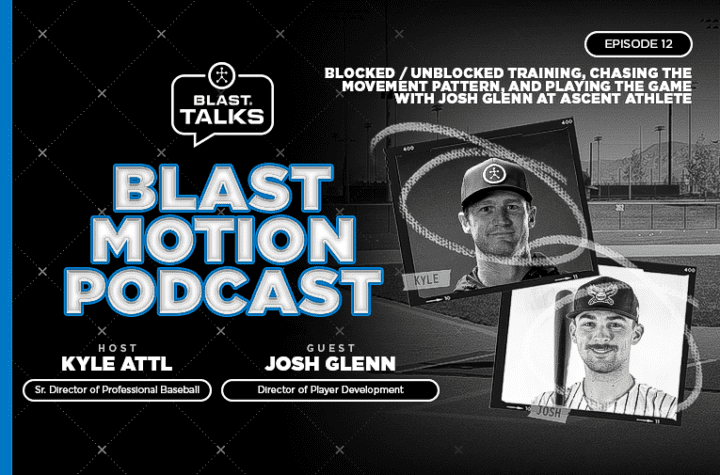We recently sat down with John Peabody to talk about bat path angle, its importance to successful hitting, and much more.
As a former minor league baseball player and the current director of Peabody Baseball, John Peabody is a highly respected and sought-after hitting coach. Peabody works with hitters of all ages and levels – from youth baseball to the college ranks, all the way up to the top pick of the 2016 MLB Draft, Mickey Moniak.

BlastMotion recently sat down with John Peabody to talk about bat path angle, its importance to successful hitting, and much more.
The San Diego-based Peabody has also teamed up with Blast to serve as a Baseball 360 Ambassador. Peabody is a big believer in Blast’s technology and regularly utilizes Baseball 360 in his training sessions.
Baseball today is awash in statistics and metrics. But there’s one metric that Peabody believes is more important than the others. That metric? Bat path angle – also known as “attack angle.”
“Bat path angle is the angle that you’re attacking the ball at with your barrel, pre-contact,” explained Peabody. “For me, when it comes to Blast Motion, it’s ultimately the most important metric that they measure. I want to know if my guys are swinging up, because I know if I can get a guy to hit the middle of the ball – that he’s going to give himself a chance to hit something hard in the air; hit a line drive.”
“When you’re swinging down on the ball, you’re only on the plane of the pitch for so long. Beside the fact that you’re swinging down on it, the time that you’re in the zone isn’t long. So, your timing has to be that much better (to make up for it). You have to be that much better at hitting the perfect part of the ball with that kind of downward swing. Working slightly up promotes all those things, and gives yourself more opportunity for successful contact.”
Peabody is quick to stress that bat path angle is not “the end all-be all” when it comes to hitting success, but was equally eager to emphasize its importance.
“Making contact with the right part of the bat on the right part of the ball is the other main aspect of it, but the attack angle is huge,” said Peabody. “Being able to be in the zone a little bit longer, whether that be earlier in the swing or later in the swing – makes it so you don’t have to be perfect. You can be a little off, but make contact because you’re still on plane and you’re still in the zone.”
So how exactly does a hitter create a better bat path angle?
“It’s not always that easy,” explained Peabody.
“Sometimes it’s a simple fix, just tell a guy to try to hit a ball a little bit higher than what he’s trying to do. And to do that, most of the time, they’re going to figure out how to get the barrel working slightly up, to make the ball go a little bit higher. There are things that we try to do, as far as getting your top hand under the bat, or getting your elbow under the barrel. Mechanics that we talk about to help get behind the ball or to get on the plane a little bit early – so we can make sure that we’re giving ourselves a chance to work level to slightly up, depending on the pitch location.”
Mechanics and Metrics.
In addition to making adjustments to hitting mechanics, cutting-edge technology is an invaluable tool. By recording and clipping video and measuring metrics like swing speed, time to contact, power and bat path angle, Baseball 360 helps hitters train smarter and get better. It also empowers their coaches, like Peabody, to make changes to attack angles that are less than ideal.
“It helps players and coaches, because a lot of the times, we can’t see that part of the swing,” explained Peabody. “When I’m throwing live to my hitters or I’m working in front of them, I know I can’t see that – especially when you’re working with guys that are swinging the bat from 80-85 miles an hour.
Baseball 360 also helps hitters themselves understand what, where and how they can make improvements to their swing.
“It gives them factual data to whether they are doing what they want to do,” said Peabody. “And I think that’s the bottom line. We talk about wanting to swing slightly up. Well, now you have something that tells you whether you are doing it or not. So gauging the metrics of what’s happening, I think is a good thing. It can be taken too far, but in Blast’s case, to be able to have the sensor tell you whether you are doing it or not, to me, only makes sense to use as a player or to train your players with if you’re a coach or a parent.”
In addition to utilizing Baseball 360, Peabody runs his players through a variety of drills and exercises during his training sessions.
“Sometimes it takes some time to do these things, but I’ll do anything from high-tee drills to low-tee drills, use pads to squeeze between your bicep and your forearm to help the barrel get flat and get in the zone earlier and stay through the zone a little bit longer.”
Peabody does his best to tailor each set of drills to specific hitters, including when it comes to bat path angle.
“There are some big leaguers that I’m sure have negative attack angles that are successful, but I know the majority of guys don’t. I think when you look at the group of guys that are really the most consistent hitters – and ultimately the best hitters in the world – they’re using their swing to get on base, and you’re going to see those guys with positive attack angles.”
“Most of the guys that I run into that are “negative” guys are trying to figure out how to make it positive,” said Peabody. “You should be swinging slightly up, but swinging slightly up is not the end-all, be-all to a line drive. There’s an art to being on time. There’s an art to hitting the bottom middle of the ball with the middle top of the bat. All those things combined with working slightly up will equal a good hitter.”













